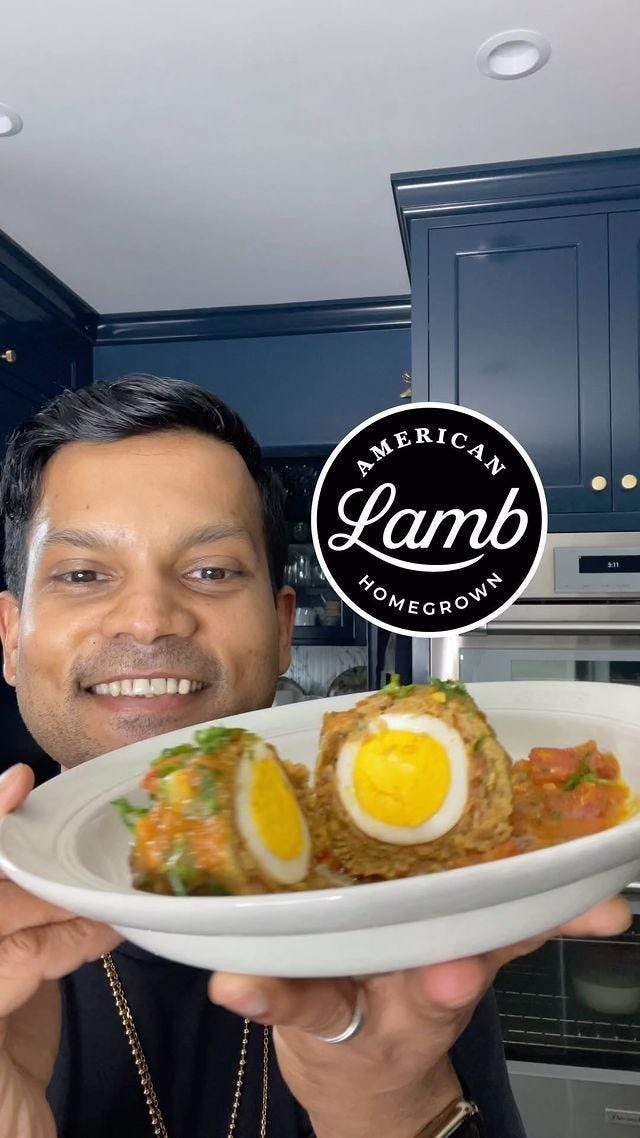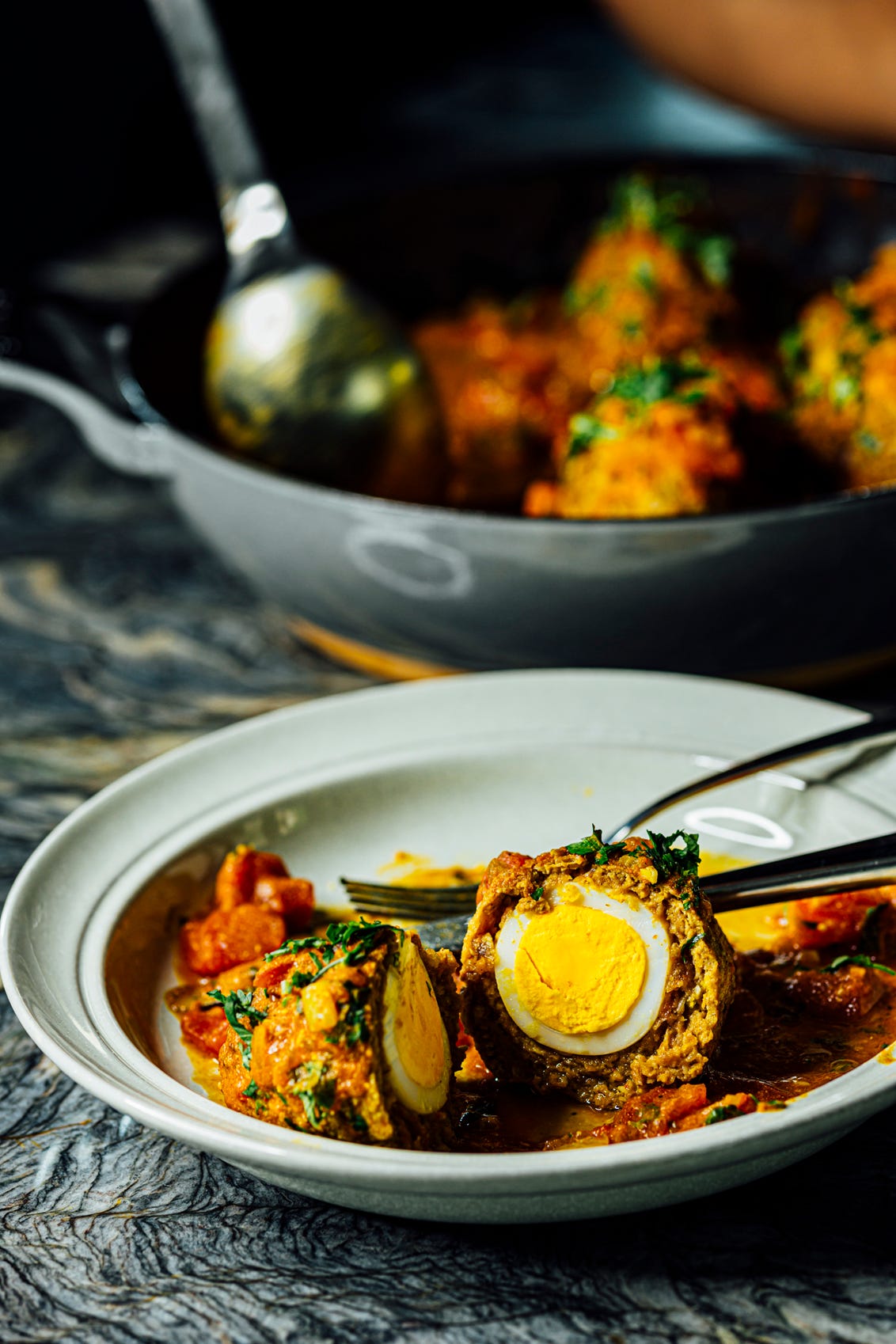How to Make One of the Most Elegant Indian Koftas - The Nargisi Kofta
A Simple Yet Elegant Kofta
I’m back home for a few days before I head back to Northern California for the Culinary Institute of America’s World of Flavor Conference and then Austin for the Texas Book Festival (my talk is on Nov 12).
I’ll be back in LA the week after for my big book dinner party with Now Serving and Chef Suzanne Goin at her restaurant, Caldo Verde (Ticket details here). I hope to see many of you there; this is the BIG PARTY!


This week also marks the start of the long holiday season, and this week, we will kick it off with Diwali (stay tuned for that newsletter that will be out very soon this week).
I recently spoke with the lovely
of that one dish. about Veg-Table, and we spoke about vegetables, biology, recipe writing, and more. Her newsletter is spectacular, and I highly recommend signing up for it, if you haven’t already.
If you have a moment to spare, please leave a review for Veg-Table on Amazon, Barnes and Noble, Waterstones, or the many indie bookstores where you purchased the book. Thank you!
This delicious recipe is made in partnership with The American Lamb Board. All opinions expressed are solely my own.
Seated across a large, wide oval dining table in my grandparent’s home, I first learned how to make koftas/meatballs from my grandmother. It’s a simple process: season, mix, shape, and cook. My job was to help shape the koftas, and as a child, my koftas came in different shapes and sizes. Yet, they were still cooked and served, and my grandmother never critiqued me. Instead, she encouraged me and asked me to help her make them often. She’d share her tips and tricks garnered over the years. As an adult, I find the repeated process of shaping a kofta very relaxing. I juggle a small amount of ground meat, tossing it back and forth between the palms of my hands, and watch it quickly evolve into a round little ball. Like my late grandmother, my intuition is now fine-tuned through time, and I know not to apply excessive pressure and be patient. A little oil will help my hands act like non-stick gloves and my koftas are smooth. The repeated practice has made me better and more efficient. If I were criticized too much for their looks as a child, it would have turned me off from kofta making for life. I’m thankful for my grandmother’s kindness. Like a kofta, our minds are shaped through experience; all it takes is one negative moment to scar. Patience and compassion are imperative when teaching to cook, a concept I believe we must always be cognizant of.
What are Koftas?
If you’ve made meatballs, then you’ve made koftas. Koftas are the Urdu word for pounded meat dishes, where ground meat is seasoned and shaped into a small ball or flat disc before cooking. In India, several variations of koftas are made with different types of meat or vegetables. In many instances, and we’ll get to this in a little bit, ground meat and some type of starchy grain or vegetables are used together to hold the meat together and prevent it from falling apart during cooking. Koftas can be deep-fried, shallow-fried, or baked, and I’ve even had success with my air fryer. I prefer the texture of the crust frying provides, but there’s a way to cheat and tweak. I’ll bake or air fry the koftas and then pan-fry them in a tiny amount of oil to make that crust a bit crispier and tastier.
The Nargis Kofta
The nargis kofta gets its name because, when sliced through, it resembles the daffodil or the narcissus flower with its bright yellow and squeaky white rings hidden inside the layer of ground lamb. The koftas are cooked separately (I’ve listed the air fryer settings I used in my Breville Joule Oven Air Fryer Pro) and then added to a stew made of onions and tomatoes. Some of you might be shocked that I used canned tomatoes over fresh, but I prefer their richer taste, and because they’re already precooked, the sauce's texture is excellent. You’ll also notice I use the same spices in the koftas and the stew, but I add extra cardamom to the stew to make it more fragrant.
Making the Koftas
I’m using American lamb to make these gorgeous nargisi koftas because the quality is exceptional. It’s got a smooth and buttery flavor, and it’s raised locally. Having visited several ranches and farms, I’ve seen the care and effort that American farmers and ranchers put towards raising their animals. When you buy American lamb, you’re supporting the families of the farmers and workers.
Shaping and cooking the koftas is probably the most time-consuming portion of this recipe, but it’s also the most straightforward. There are a few things to watch out for :
Hardboiled eggs are slippery, little guys. Don’t aggressively try to coat the meat around them; pat them gently, and it will hold.
The ground lamb will start to get sticky as it warms up, so lightly grease your hands with oil and then shape the koftas.
Ground meat, when heated, starts to lose water fat, and the proteins denature and shrink. As the koftas cook, the meat layer can crack and break, which isn’t the end of the world. To avoid this, I prepare a panade by mixing the ground meat with panko breadcrumbs, an egg, and a yolk, with the other ingredients in a food processor to make a coarse paste. I find a panade a better option because the starch from the panko breadcrumbs will absorb the juices released during cooking and hold the meat much more nicely than pure cornstarch or flour. A food processor is a better option than a blender because it’s easier to control the speed and prevent the ground meat from becoming mush, and the meat doesn’t get stuck under the blades (it’s easier to clean).
Be gentle when handling the koftas, especially when adding them to the tomato stew. The liquid will make them tender, and they can break. There’s no need to stir them; top them with spoonfuls of the stew as they cook.
Serving Options
What I love about these nargisi koftas is that it’s a great dish on its own and needs nothing except for some hot steaming rice or a flatbread like parathas or naans to sop up the rich tomato stew. It also freezes exceptionally well, so this is a dish you can make ahead and reheat when needed.





